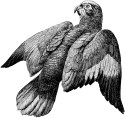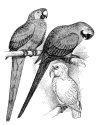|
Parrots are a broad order of more than 350 birds.
The parrot classification includes: macaws, Amazons,
lorikeets, lovebirds, and cockatoos.
Parrot Classification:
Kingdom: Animalia
Phylum: Chordata
Class: Aves
Infraclass: Neognathae
Order: Psittaciformes
|
Other Names: Macaws, Cockatoos,
Parrot in Foreign Languages:
Afrikaans: papegaai
Albanian: papagall
Ancient Greek: psittakos
Arabic: babbaghaa' / dúrra
Armenian: t’ut’ak
Azeri: tutuqusu
Belarusian: papuháj
Bosnian: papagaj / papiga
Bulgarian: papagal
Catalan: lloro
Chamicuro: tulo
Cherokee: tsisqua-gawonisgi
Chinese: Mandarin: yingwu
Croatian: papagaj / papiga
Czech: papoušek
Danish: papegřje
Dutch: papegaai
Esperanto: papago / psitako
Estonian: papagoi
Faroese: pappageykur
Finnish: papukaija
French: perroquet
Galician: papagaio
Georgian: t‘ut‘iquši
German: Papagei
Greek: papagálos
Haitian Creole: jako
Hawaiian: paloke, manu paloke,
manu aloha
Hebrew: túki
Hindi: tota / toti / shuk
Hungarian: papagáj
Icelandic: páfagaukur
Ido: papagayo
Indonesian: nuri
Interlingua: papagai
Irish: pearóid
Italian: pappagallo
Korean: aengmusae
Latin: psittacus
Latvian: papagailis
Limburgish: pappegei
Lithuanian: papuga
Low Saxon: Papegai / Papegoi
Lower Sorbian: papagaj
Macedonian: papagá
Malay: nuri
Manx: parrad
Maori: kaka
Mongolian: tot’
Navajo: tsídii yálti'í
Norwegian: papegřye
Occitan: papagai
Ojibwe: gaagiigidoo-bineshiinh
Ossetian: tuti
Pangasinan: kulasisi
Pashto: toti
Persian: tuti
Polish: papuga
Portuguese: papagaio
Rohingya: tuta
Romanian: papagal
Russian: popugáj
Scottish Gaelic: pearraid / pitheid
Roman: papagaj / papiga
Sicilian: pappagaddu / pappaiaddu/
pappajaddu
Slovak: papagáj
Slovene: papiga / papagaj
Spanish: papagayo / loro / cotorra
Swahili: kasuku / dura / kwao
Swedish: papegoja
Tagalog: loro/ pariko/ piriko
Thai: gâew / nók gâew
Turkish: papagan
Turkmen: toti
Ukrainian: papúha
Urdu: tota / toti
West Frisian: pappegaai
Yiddish: popugay / popugaj / papuge
|
|

Parrot
Conservation Status: Some species are
Endangered



|
Species: There are approximately 372 different
parrot species. Parrots are grouped into Grouped into
two families, Psittacidae which are considered true
parrots and Cacatuidae which include cockatoos.
Size: Parrots vary in size from species to species.
Parrots weigh from 2.25 oz to 3.5 lbs. Parrots are 3.5
inches to 40 inches tall.
Habitat: Parrots are found all over the world
in warm climates. Most parrots are found in Australasia,
Central America, and South America.
Description: Parrots are large and often domesticated
birds. Parrots are often colorful, they have curved
beaks, strong legs and clawed feet. Parrots have four
toes, two toes point forward and two toes point backwards.
Diet: Parrots eat seeds, fruit, nectar, nuts,
flowers or small insects.
|
Communication: Parrots are highly vocal
and communicate through a variety of sounds.
|
Did You Know?
Parrots are monogamous and they mate
for life!
|
|
Incubation: The incubation of a parrots eggs
varies from 17 to 35 days, with the larger parrot species
have the longer incubation periods.
Birth: Wild parrots build their nests in holes,
trees, termite mounts, rock cavities, or ground tunnels.
Sexually Mature: Parrots sexually mature between
1 and 4 years of age depending on the species.
|
Life Span: Some large parrots live up
to 80 years in the wild. Smaller parrot species
live around 15 years of age.
|
Did You Know?
Wild Macaws and Cockatoos can fly up
to 500 miles in a day, while searching
for food.
|
|
|











